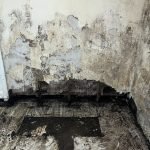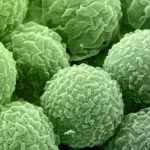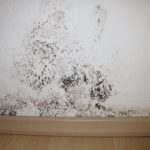
What to Do About Mold in Your Air Conditioner
In the hottest summer months, we are grateful we live with the modern technology of the air conditioner. We’ve become so accustomed to this luxury we can often take for granted the care that’s required to maintain such amenities. One frequent concern when regularly running an air conditioner is the growth of mold.
Why is There Mold in the Air Conditioner
Mold is a fungus that grows in damp, dark places. The air conditioner’s drain line can get clogged with leaves and other debris from the outside. This causes water to back up and leak into the AC unit, which will grow mold on its interior surfaces.
To prevent this problem, AC lines should be cleaned out and drained periodically. Improper draining is common, especially if you have an older system without a condensation pump (such as one installed before 1990).
Be sure to check for leaks under the unit or along any pipes running to the outside of your house. Having a clean AC unit can significantly help with eliminating musty odors, preventing mold or mildew growth and help keep your energy bills low.
There are also many commercial products available to help keep your A/C clean inside and out. These should be used according to instructions provided by their manufacturers.
How to Detect Mold in Your Air Conditioner
Every homeowner should know how to spot mold in their cooling system. It may be difficult to detect that a problem is growing in your house. The more time
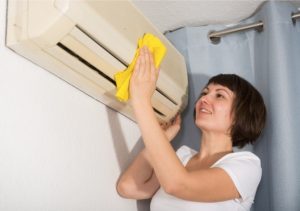
spent undetected the more time that it can spread, so be careful and check your units on a routine basis.
You can test for mold in the air conditioner by being aware of what to look for, and what smells occur in your home. Here are some signs that there may be some fungi lurking there:
- A noticeable musty smell near the air vents in the indoor environment.
- The distinct odor increases when the air is running.
- Patches of black fungi are visible around the vents, evaporator coils, or drip pans.
- You or your family have an irritated throat, nose, eyes, or sinus passage when the cooling is on.
How to Clean Mold in Your HVAC Units
AC units come in many shapes and sizes and vary in the way they are assembled. It’s a good idea to check your owner’s manual to determine how to identify and disassemble the unit so you can access the interior. Before cleaning, assemble your tools and materials and be sure to wear a dust mask, goggles, and gloves.
Saturate a scrubbing sponge in a bleach solution (a few gallons of hot water and about 1/2 cup of household bleach)
Wipe the inside surfaces of the AC unit with the solution, removing all traces of visible mold. The bleach will kill residual spores.
Getting Rid of Mold in Air Vents
Mold is a naturally occurring substance that can be found just about anywhere, but it should not be allowed to grow inside an air conditioning unit. If you have mold growing on the coils of your AC, call an HVAC system professional to take a look. Here are a few ways to eliminate mold in your air vents:
- Vacuum the inside of the exposed duct to remove any dust within reach.
- After 15 minutes, remove the vent grille from the basin, rinse with clean water and allow it to air dry.
- Spray the interior of your duct with water to prevent spreading the dry mold dust around.
Wipe down the duct surfaces with soapy water and let dry before reassembling.
Preventing Mold Growth in Your AC Unit
Fungi and bacteria that thrive in moist environments can grow on the inside of air conditioning units, leading to a musty smell and causing health problems. Mold can cause respiratory issues such as sinus problems or headaches for those with allergies or respiratory issues. These pesky spores have been known to trigger asthma attacks as well.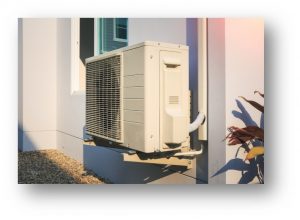
Fortunately, there are ways you can prevent this from happening. You should make sure your AC unit isn’t leaking by periodically checking condensation levels at the bottom of your unit with a flashlight—if it’s wet down there, you may want to get someone out to look at the unit right away! You should also make sure that your AC unit is properly insulated. A well-insulated system will not let in as much warm air and moisture, which means less mold growth.
One last thing you can do to prevent mold from growing inside of your vents is to change the filters regularly according to the manufacturer’s instructions.
Is it Safe to Run Air Conditioner With Mold?
Running an air conditioner with mold is not safe and can pose health risks. Mold can grow in the cooling coils, ducts, and other parts of the system, releasing spores into the air. Inhaling these spores can lead to a range of health problems, particularly for individuals with allergies, asthma, or compromised immune systems. Symptoms may include respiratory issues, throat and eye irritation, coughing, and skin problems.
If you suspect mold in your air conditioner, it’s crucial to address the issue promptly. Turn off the unit, clean or replace filters, disinfect affected areas, and consider professional assistance for severe mold infestations. Proper maintenance and mold prevention measures are key to ensuring your air conditioner runs safely and efficiently.
How Do the Professionals Remove Mold?
Mold in air conditioning is a common problem in homes and businesses alike. It can be found anywhere that has moisture, which includes your air conditioning unit. Though there are many types of mold, the most dangerous type for humans is black mold. This particular fungus thrives on moist environments such as those found within an AC unit or inside walls where water damage has occurred from leaks or high humidity levels.
The musty smell caused by this type of fungi will cause headaches and sinus problems for some people with allergies, causing allergic reactions or respiratory issues; it may also trigger asthmatic attacks if they have already been diagnosed with asthma. Additionally, some people could suffer from mold allergies causing immune system issues. Fortunately, there are ways to prevent these tiny spores from growing into larger colonies that could pose health risks to you and others.
Professionals in mold removal and restoration are trained and skilled in mold remediation processes. This includes how to set up proper containment, methods to use antimicrobial chemicals that clean any mold, stains, and mold prevention. Professionals often use a sealer or encapsulant to make the treated areas more resistant to water damage and mold, and to help with odor control.
If you need the help of a professional, contact Jenkins Environmental Services today!
[otw_shortcode_button href=”https://jenkinsenvironmentalservices.com/request-help/” size=”medium” icon_position=”right” shape=”square”]Request Help[/otw_shortcode_button]

